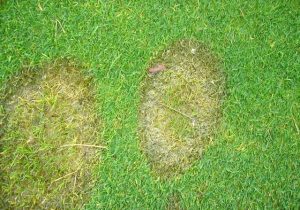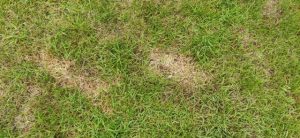So, your lawn was looking lovely. You admired it only a few days ago. Freshly mowed, lovely and green. What more could you want? Suddenly you notice something’s not quite right. The grass is changing colour… in a day or two and things look considerably worse – now you’re getting worried!
Let’s take a look at fungal attacks, what causes them, what can be done when they appear and how to prevent them.
Mushrooms are magic!
Before we get started let’s get one thing straight; there are many toadstool type fungi you may see on your lawn. They look similar to the mushrooms you buy in the supermarket, in so far as they have a stem and a cap with fins and spores below the cap. These are the fruiting body of fungi living in the soil and they are generally an indication of good, healthy soil with lots of organic matter. They may be poisonous, so if they are bothering you and you want to remove them, be sure to wash your hands afterwards.

Pathogens
Three things need to be present for a fungal attack to occur. The pathogen needs to be present; conditions need to be right to support the pathogen and there needs to be a host for the disease. Most of the pathogens that cause an outbreak will already be present in your lawn. When weather conditions support the proliferation of these pathogens their aim will be to multiply and colonise other areas. This is when that small area of concern that you initially noticed can become a real eyesore.
Appearance
Knowing what you’re looking for is important. It’s easy to misidentify and become concerned unnecessarily. What’s more important however is knowing what you can do to prevent these often-devastating outbreaks – more on that later. Whilst most fungal attacks are unsightly, the good news is that they rarely kill the grass plant and mostly their impact is on the leaf and therefore on the appearance of your lawn. That being said, don’t underestimate the devastating effect they can have on the appearance of your lawn over a long period of time. Your lawn may look unsightly for the whole summer.
Once the disease appears focus needs to be on aiding recovery and limiting it’s spread. Yes, we can apply a fungicidal treatment at this time but, on the whole, once you see it the damage has already been done and you won’t reverse that. The other thing to consider is that fungicides are not entirely your friend. They are indiscriminate and therefore also kill beneficial soil fungi, essential for a healthy lawn.
We work hard to develop friendly fungi in the lawns because their benefit within the soil is magnificent. We don’t want to undo that with one unnecessary application for an outbreak that we could have prevented with the right preparation.

Treatment
When we discover a fungal attack, our focus is on treating the grass not treating the fungi. As mentioned earlier, on the whole the grass will recover, and our efforts are focussed on aiding that recovery. We are the Florence Nightingale to your poorly lawn, but usually without a lamp!
So rather than applying a fungicide which will have little positive impact we focus on boosting nutrition, re-growth and therefore recovery. Through the spray application of a specialised blend of macro and micro-nutrients, liquid seaweed concentrate, carbohydrates and magnesium, we aim to give your lawn a shot-in-the-arm and get it growing again so the greenery returns as quickly as possible
Prevention
We all know that prevention is far better than cure. We have considered what the outbreak looks like and what we can do once it happens. We have also identified what factors contribute to a fungal outbreak and we now know that some of these factors are outside of our control; the weather being a major contributor. So, what can be done to reduce the risks of a fungal attack thwarting your lawn bragging rights?
6 steps to lawn disease prevention
- Firstly, think about the grass itself. Certain varieties are more susceptible than others. Some of the modern grasses have been bred specifically for their disease resistance and whilst more expensive they should always be selected when adding seed to an existing lawn.
- Next comes your mowing regime. The right frequency and mow height with sharp blades is essential. Poor mowing weakens grass plants and weak plants are more susceptible to attack.
- Then we have nutrition. Any living thing that is not receiving the right nutrition is more likely to become ill. The risk of the illness can be reduced through the right nutrition, as can the speed of recovery. Your lawn is no different. Occasional feeding is not enough. The right products, in the right quantity, at the right times is essential.
- We then have environmental factors. Disease pathogens love thatch and mossy lawns. Reduce these conditions through regular scarification and aeration. The latter aids stronger root development and with this come greater access to nutrition and water.
- Air flow is important too. Enclosed lawns with overhanging trees are more prone the fungal attacks than lawns that have a good flow of fresh air.
- That brings us nicely on to watering. Drought causes stress -stressed plants are more likely to be affected by fungal outbreak. Watering is important – correct watering is essential. Often fungi like warm wet conditions. Try to prevent these conditions by watering in a morning so the sun dries the grass leaf quickly and it doesn’t stay wet all night.
Finally, as lawn care professionals we monitor conditions through national turf-care reporting systems which enable us to predict when an outbreak might occur. We know which of our clients have lawns that are more susceptible to fungal disease, and we are then able to notify them in advance and recommend preventative treatments where they are most needed.

 Established 2016
Established 2016



